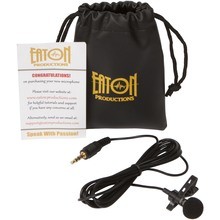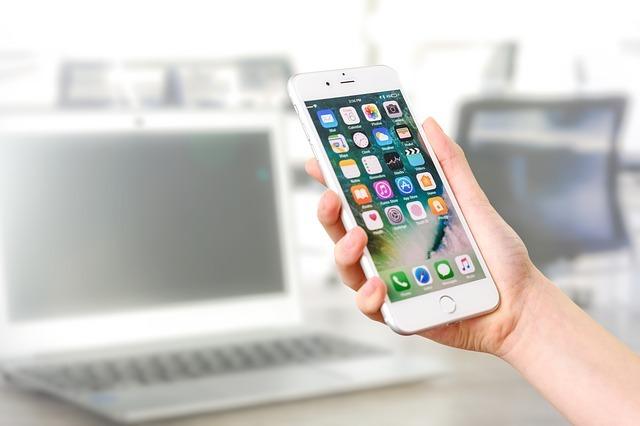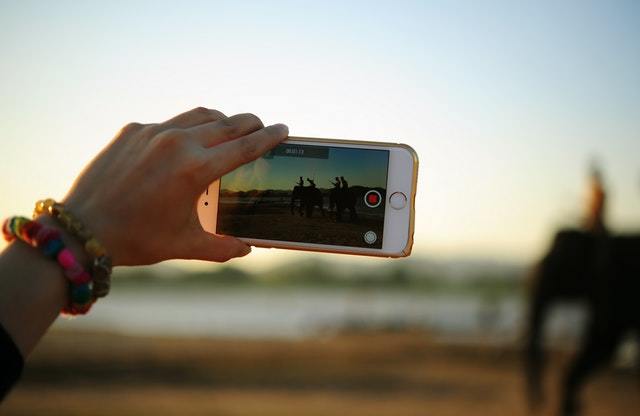- in Video
What microphones should you use with your iPhone or Android phone?

In this post we’ll discuss smartphone microphones.We’ll look at:- Why it’s not ‘smart’ to use your smartphone’s inbuilt mic…- How to get better audio when recording with a smartphone or tablet – What microphone should you use with your iPhone or Android phone?
Why it’s not ‘smart’ to use your smartphone’s inbuilt mic…

Today, we’re looking at tips on how to record good quality sound with our smartphone (or tablet).Now it’s not quite as troublesome as you may be thinking, however there are some challenges you need to be aware of.Of course mobile phones are amazing, they really are super convenient – portable, lightweight, and always with us.We appreciate that we can get superb, high quality photos as well as video footage out of them, but why do they let us down in terms of audio?The explanation is simple – it’s the on-board microphone.I should mention at this point, that this problem is not exclusive to mobile devices, it is also the problem with most cameras, even high end DSLR’s.The problem is that when you’re just using the inbuilt microphone, the audio will pick up a lot of the background noise and won’t be too clear.Background noise is an interference or hiss in the audio recording that is not part of the desired sound for your video or audio project. This noise distracts from the viewer/listeners experience, and does not provide an engaging environment.In extreme cases it makes the intended audio so distorted that people will simply click away, it’s well known that bad audio is an instant turn off.You will hear exactly what I’m talking about when you listen to the video later in this post, to hear the difference more distinctly, put some headphones on (or just the earphones that came with your phone).Now it’s not all doom and gloom, don’t let anything stop you getting your content out there, if right now you have nothing other than your phone or tablet, there are things you can do to help as much as possible…
How to get better audio when recording with a smartphone or tablet (and nothing else)

CREATE A CONTROLLED ENVIRONMENT
Keep your environment as quiet as you possibly can, turn off air conditioners, fans, televisions, radios etc. Shut windows and choose a time of day when the traffic is quieter, children aren’t back from school and out playing in the garden – you know, general common sense really.Sometimes we just have to do the best we can. My video studio is set up in a cabin in our garden, and because the weather is boiling hot here in England, UK this summer, I need to have the fan on sometimes.Here is a tip though, a fan or air conditioning unit or any ‘constant’ and ‘consistent’ background noise, can be edited out afterwards. Variable background noise is much more difficult to deal with.In the video below you can see I have the fan on, but I edited out the background noise afterwards using Audacity, or maybe it was Camtasia Studio, I use both and I can’t remember exactly which it was.By the way, the fan was pointed at me and was static, the noise was quite consistent. I recorded a video at some other point where the fan was oscillating, this was not so good at all, because every time the fan passed by the microphone the sound was louder.
If you want to learn how to use Audacity to remove noise you can do that here.
BE AS CLOSE TO THE MICROPHONE AS POSSIBLE
Another tip is to keep your mouth as close to the microphone as possible, this will help most of the captured audio be your voice, and not the background sound present in the room.To be honest you should try to do this anyway, ask any voice over professional – it captures much more of the resonance in your voice. Men will sound so much deeper and so will women to some extent. It helps us to not sound so ‘tinny’, if you get my drift.
BACKGROUND MUSIC
You can use background music to ‘cover up’ any noise, just be sure not to have the levels so loud so that it overpowers the vocals.Music can help with getting your audience ‘in the mood’ and enhance engagement, do you remember that music from the film ‘Jaws’?Or how about the chilling music from the film ‘The Omen’ – Carl Orff – O Fortuna ~ Carmina Burana.Perhaps those examples are a little extreme, but I hope it helps you to see my point.Make sure that your music is royalty free, check the terms and conditions carefully. Both Facebook and YouTube have a collection of music you can use in your videos, but still do your due diligence and check the terms of use.
better audio tips (without external microphone):
- Edit out ambient noise afterwards with Audacity
- Be as close to the microphone as possible
- Use background music
What microphone should you use with your iPhone or Android phone?
In this video I go through a few options that you have instead of using the inbuilt microphone.I have the windows of my studio open because it is so hot. You can hear aeroplanes going over and a train in the background, it’s acceptable though, and doesn’t distract from the content too much.I didn’t edit out any of the background noise because the whole point was to demonstrate how the microphones deal with it.This video was shot with an iPhone 6+ and the studio is a log cabin which has quite a bit of echo.
lavalier Microphone links:
Grab your Eaton Productions microphoneEaton Productions MicrophoneGrab your Rode SmartLav+ microphonehttps://amzn.to/2CZKlvy
I trust you can hear the difference when plugging an external microphone into your smartphone, the sound suddenly becomes crisp and clear.Of course there are other microphones you can use, but I can only show you the difference with the microphones I have. I’m not comfortable recommending anything I haven’t tried and can’t demonstrate myself.Some of the other options would be mini boom microphones that sit on top of your device (I believe they are more directional, but you would still need to factor in your proximity to the mic). Remember also that with directional (sometimes called unidirectional) that you really can’t be moving around too much, like turning your back to look at a whiteboard etc. The voice will suddenly go ridiculously quiet. The positioning of the microphone and your intended presentation will need to be planned accordingly – to be fair, this is true of most microphones and your intentions when it comes to shooting your videos.Then there are wireless lavalier (lapel) microphones, which do the same job but without the wires… I have heard that these can be fabulous, but you have to be careful what frequencies they use (some that are used abroad, are not allowed here in the UK, and vice versa), and where you buy them from.These are also expensive, so unless you absolutely need to be a fair distance from the camera and have freedom from the wires, why would you?You can also now buy adapters, so you can use your USB mic (like a Blue Yeti) with your mobile phone…I might try this one in the near future… but I find that I still get background noise with the USB mics, so I’m struggling to think why?If you listen to the first video where I show me talking with the fan on, I am using my computer and Logitech C920 webcam, and the Blue Yeti microphone. I have applied noise reduction to it with Audacity.Then listen to the last part of the second video where I am speaking using my iPhone 6+ and the lavalier microphone, I haven’t applied noise reduction to that one.Unless you wear headphones or are a professional sound technician, for most purposes the sound quality is fine.There are other solutions – a Zoom digital audio recorder is highly recommended by many.These are not cheap either but you can have a professional audio recording from these. You should bear in mind that this would have to be synchronized to your video in the editing software afterwards.Another thing you can do if you want to be closer to your camera – or microphone is to use a wide angle lens.This is because it will capture a larger area, and not have you filling up the shot, or frame. Sounds strange but I have tried it and it does help somewhat.I will do another post about that in the near future to show you what I mean.I bought a relatively cheap wide angle lens for my iPhone 6 Plus from Aldi UK, I can’t remember exactly but it was around £10.
In Conclusion:
If you want to buy lots of accessories and gadgets, you can use a higher end smartphone or tablet as a full featured video solution.But I think, as far as I can see at the moment, the price of getting all the bells and whistles – especially some of the mounts – make it not quite worth it – at least for now.You can shoot perfectly great video and audio with your smartphone for most situations.When you want to step it up you can move onto DSLR and the new Mirrorless cameras.You won’t know what you need until you start, and only when you are struggling to achieve a particular outcome will you know what that might be.Oh and I should mention, my favourite at the moment is my Logitech C920 webcam, which shoots in 1080HD, and my computer, with either my Blue Yeti microphone, or my beloved Audio Technica AT2020.Most microphones are specific for a purpose, and there is personal preference and also the volume and tone of your own natural voice to take into consideration, so it would be silly to say that any particular microphone is suitable for everybody in every situation.That’s my advice anyway, for what it’s worth 🙂